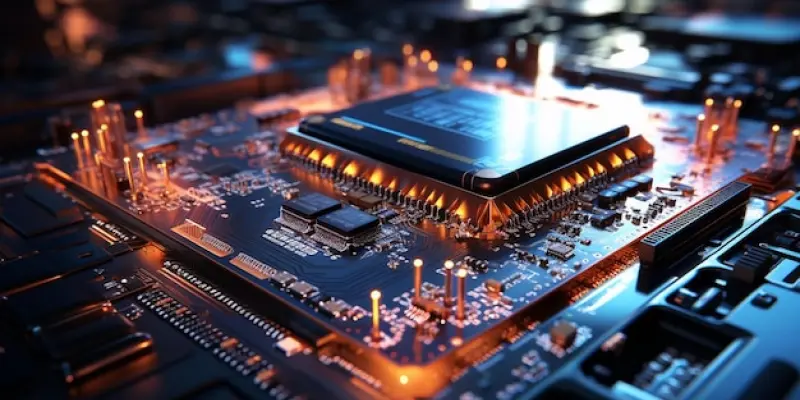In the ever-evolving world of technology, the demand for smaller, more powerful, and energy-efficient components has never been higher. This trend is especially evident in sectors such as medical and consumer electronics, where devices like wearables and smart home gadgets are pushing the boundaries of miniaturization. Texas Instruments has taken a significant step forward in meeting this demand by introducing the world’s smallest microcontroller, the MSPM0C1104, which measures a mere 1.38 mm²—akin to the size of a black pepper flake. This tiny yet powerful microcontroller is poised to revolutionize the landscape of compact electronics, offering a range of features that make it ideal for a variety of applications.
Texas Instruments’ Breakthrough in Microcontroller Design
Essential Features of MSPM0C1104
Texas Instruments’ MSPM0C1104 microcontroller is part of the company’s Arm Cortex-M0+ MSPM0 MCU portfolio and utilizes advanced wafer-level chip-scale package (WLCSP) technology. This makes it 38 percent smaller than competing devices, allowing for greater design flexibility in extremely compact gadgets. Despite its minuscule size, the MSPM0C1104 doesn’t compromise on performance. It boasts a 12-bit analog-to-digital converter (ADC) with three channels, six general-purpose input/output pins, and supports standard communication interfaces such as UART, SPI, and I2C. These features make it an excellent candidate for use in devices ranging from medical probes to smart earbuds, where space is of paramount importance but robust computing power is still required.
Operating at frequencies up to 24 MHz on an enhanced Arm Cortex-M0+ core, the MSPM0C1104 includes 16 KB of embedded flash memory and 1 KB of SRAM. This embedded memory ensures that the microcontroller can handle a variety of tasks without needing additional external memory, thus saving even more space in compact designs. Additional features set this microcontroller apart, such as a high-speed on-chip oscillator with an accuracy range from -2 percent to +1.2 percent, negating the need for an external crystal. Furthermore, the MSPM0C1104 includes a single-channel DMA, a CRC-16 accelerator, and an on-chip temperature sensor. These advanced features are complemented by several intelligent digital peripherals, including advanced and general-purpose timers and a watchdog timer, making it a well-rounded solution for an array of compact electronic applications.
Energy Efficiency and Deployment
One of the most standout aspects of the MSPM0C1104 is its remarkable power efficiency, crucial for battery-powered devices that require extended battery life. The microcontroller consumes only 87 µA/MHz when active and a mere 5 µA in standby mode with SRAM retention. This makes it highly suitable for applications where long battery life is essential, such as in wearable health monitors or IoT devices. Moreover, the MSPM0C1104 operates over a wide temperature range from -40°C to 125°C and functions efficiently on supply voltages between 1.62V and 3.6V, ensuring it can be reliably used in various environments and conditions.
Texas Instruments supports the MSPM0 MCU portfolio with an array of resources and tools to facilitate development and deployment. Over 100 pin-to-pin compatible MCUs are available, starting at just $0.16 per unit for 1,000-unit quantities. Developers have access to a comprehensive software development kit and hardware development kits, as well as reference designs and tools like Zero Code Studio, which streamline MCU application development processes. For those seeking additional support, Texas Instruments provides a wealth of online resources, including the MSP Academy and TI E2E support forums. The company also offers a LaunchPad development kit specific to the MSPM0C1104, featuring an onboard debug probe that aids in programming and debugging.
Broader Implications for Compact Electronics
Impact on Consumer and Medical Electronics
The introduction of the MSPM0C1104 by Texas Instruments is more than just a technical advancement; it represents a potential paradigm shift in the design and functionality of compact electronic devices across various industries. In the realm of consumer electronics, this tiny microcontroller could significantly enhance the performance and usability of wearables such as fitness trackers, smartwatches, and wireless earbuds. By providing robust computing power in a very small footprint, manufacturers can develop more advanced features and functionalities without compromising on design aesthetics or usability. For instance, enhanced sensors in wearables can offer more accurate health metrics, while smart home devices can become even more integrated and responsive.
In medical electronics, the MSPM0C1104’s small size coupled with its high efficiency and performance opens up new possibilities for medical probes, portable diagnostics, and implantable devices. These applications demand high precision and reliability, which the MSPM0C1104 can deliver thanks to its advanced ADC, versatile communication interfaces, and accurate on-chip sensors. The energy efficiency of this microcontroller also means that battery replacements for critical medical devices can occur less frequently, reducing patient discomfort and logistical challenges. Overall, the MSPM0C1104 exemplifies how advancements in microcontroller technology can drive innovation and improve user experiences across multiple application domains.
Texas Instruments’ Vision and Next Steps
In today’s rapidly advancing technological landscape, the push for smaller, more powerful, and energy-efficient components is at an all-time high. This demand is particularly noticeable in fields like medical and consumer electronics, with devices such as wearables and smart home gadgets driving the need for further miniaturization. Addressing this trend, Texas Instruments has made a notable advancement by launching the world’s tiniest microcontroller, the MSPM0C1104, which boasts an incredibly compact size of just 1.38 mm²—comparable to a black pepper flake. This minuscule yet robust microcontroller is set to transform the world of compact electronics. It provides a host of features making it exceptionally suited for a wide range of applications, enhancing performance while maintaining a small footprint. As the demand for space-saving, high-efficiency components grows, innovations like Texas Instruments’ MSPM0C1104 pave the way for the next generation of smart, sleek, and energy-efficient devices.

